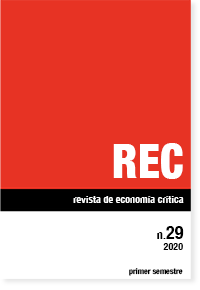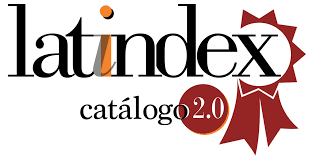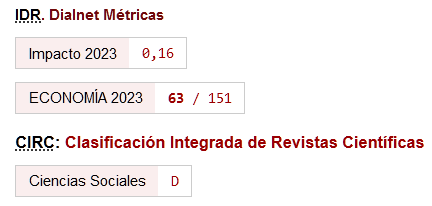Monetary endogeneity hypothesis in a dollarized economy: the Ecuadorian case (2015-2018)
DOI:
https://doi.org/10.46661/rec.10144Keywords:
econometric endogeneity, instrumentsl variable, liquidity, credit portfolio, interest rate, monetary endogeneityAbstract
The objective of this paper is to analyze the theoretical bases of the post-Keynesian current corresponding to the hypothesis of monetary endogeneity and to establish its adjustments to a dollarized economy such as the Ecuadorian case. Through the methodology of instrumental variables, the econometric endogeneity caused by the simultaneity between the level of liquidity and the credit portfolio of commercial banks is corrected, using as an instrument the average of the maximum reference interest rate established by the Monetary Policy Board and Financial The main result obtained was the fulfillment of the hypothesis of monetary endogeneity under post-Keynesian horizontalist assumptions in a dollarized economy such as the Ecuadorian case.
Downloads
References
Dimand, Robert (2000). "Irving Fisher and the quantity theory of money: the last phase". Journal of the History of Economic Thought, 22(3), pp. 329-348.
https://doi.org/10.1080/10427710050122549
Fisher, Irving (2006). The purchasing power of money: its determination and relation to credit interest and crises. Cosimo, Inc.
Fisher, Irving, & Brown, Harry (1914). "The Purchasing Power of Money, its Determination and Relation to Credit, Interest and Crises". Bull. Amer. Math. Soc, 20, pp. 377-381.
https://doi.org/10.1090/S0002-9904-1914-02503-0
Fontana, Giuseppe (2003). "Post Keynesian approaches to endogenous money: a time framework explanation". Review of Political Economy, 15(3), pp. 291-314.
https://doi.org/10.1080/09538250308431
Friedman, Milton, & Schwartz, Anna (2008). A monetary history of the United States, 1867-1960. Princeton University Press.
https://doi.org/10.1515/9781400829330
Friedman, Milton (1959). "The demand for money: some theoretical and empirical results". Journal of Political Economy, 67(4), pp. 327-351.
https://doi.org/10.1086/258194
Frost, Peter (1977). "Short-Run Fluctuations in the Money Multiplier and Monetary Control". Journal of Money, Credit and Banking, 9(1), 165. doi:10.2307/1992017
https://doi.org/10.2307/1992017
Grubisic, Elena, & Manteiga, Marilina (2000). "Modelos de predicción de Agregados Monetarios". Banco Central de la República Argentina, Nota Técnica nro, 9.
Hansen, Alvin (1960). "Teoría monetaria y política fiscal". (No. 336.741. 28). Fondo de Cultura Económica.
Hoggarth, Glenn (1997). Introducción a la política monetaria. Centro de Estudios Monetarios Latinoamericanos.
Howells, Peter (2010) "The money supply in macroeconomics". In: Galindo-Martin, M. A. and Spiller, C. N. , eds. (2010) Issues in Economic Thought.New York: Nova Science Publishers Inc., pp. 161-184. ISBN 9781608761739 Available from: http://eprints.uwe.ac.uk/12644
Jahan, Sarwat, & Papageorgiou, Chris (2014). "What is monetarism". Finance and Development, 51(1), pp. 38-39.
Kaldor, Nicholas, & Trevithick, James (1981). "A Keynesian perspective on money". Lloyds Bank Review, 139(1), pp. 1-19.
Larraín, Luis (1980). "La oferta de crédito bancario". Cuadernos De Economía, vol. 17, no., pp. 323- 355. JSTOR, JSTOR, www.jstor.org/stable/23830062
Lavoie, Marc (2005). La economía postkeynesiana: un antídoto del pensamiento único (Vol. 218). Icaria editorial.
Lavoie, Marc (2005). "Monetary base endogeneity and the new procedures of the asset-based Canadian and American monetary systems". Journal of Post Keynesian Economics, 27(4), pp. 689-709.
Lavoie, Marc (1992). Foundations of post-Keynesian economic analysis. Books.
Londoño, Sebastián (2016). La política monetaria en el Ecuador desde la perspectiva postkeynesiana período 2005-2015 (Bachelor's thesis, PUCE).
Lucas Jr, Robert (1995). "Monetary neutrality". Prize Lecture, pp. 246-265.
Mayer, Thomas (1980). "David Hume and monetarism". The Quarterly Journal of Economics, 95(1), pp. 89-101.
https://doi.org/10.2307/1885350
Meltzer, Allan (1995). "Monetary, Credit and Other Transmission Processes: A monetarists Perspective". Journal of Economic Perspectives, 9(9, 4), , ( pp. 49-72.).
https://doi.org/10.1257/jep.9.4.49
Mies, Verónica, & Soto, Raimundo (2000). "Demanda por dinero: teoría, evidencia, resultados". Economía Chilena, 3(3), pp. 5-32.
Moore, Basil (1989). "The endogeneity of credit money". Review of Political Economy, 1(1), pp. 65-93.
https://doi.org/10.1080/09538258900000005
Moore, Basil (1988). "Horizontalists and verticalists: the macroeconomics of credit money". Cambridge University Press.
Palley, Thomas (2002). "Dinero endógeno: significado y alcance". Teorías monetarias poskeynesianas, 67-80.
Palley, Thomas (1996). "Accommodationism versus structuralism: time for an accommodation". Journal of Post Keynesian Economics, 18(4), pp. 585-594.
https://doi.org/10.1080/01603477.1996.11490088
Patinkin, Don (2010). "Neutrality of money". In Monetary Economics (pp. 262-276). Palgrave Macmillan, London.
https://doi.org/10.1057/9780230280854_30
Piégay, Pierre, & Rochon, Louis (2006). Teorías monetarias poskeynesianas (Vol. 16). Ediciones Akal.
Piégay, Pierre, & Rochon, Louis (2005). "Teorías monetarias poskeynesianas: una aproximación de la escuela francesa". Problemas del Desarrollo, 36(143), 33-57.
Urrutia, Miguel (2002). "Una visión alternativa: la política monetaria y cambiaria en la última década". Borradores de Economía, 207.
Ravier, Adrián (2010). "La no neutralidad del dinero en el largo plazo: un debate entre Chicago y Viena". Cuadernos de Economía, 29(52), pp. 1-19.
Roca, Richard (2013). Teoría y Política Monetaria. En Teoría y Política Monetaria (págs. 27- 56). Lima- Perú: Pontificia Universidad Católica de Perú.
Roca, Richard (2002). "La tasa de interés y sus principales determinantes". Tasa de Interés, 4.
Rochon, Louis (1999). "Credit, money, and production: An alternative post-Keynesian approach". Edward Elgar Publishing.
https://doi.org/10.4337/9781781959596
Shanmugam, Bala, Nair, Mahendhiran, & Li, Ong (2003). "The endogenous money hypothesis: empirical evidence from Malaysia (1985-2000)". Journal of Post Keynesian Economics, 25(4), pp. 599-611.
Stock, James, & Watson, Mark (2004). Econometria. Agricultura em Sao Paulo, 51(2), 85.
Velásquez, Iván (2011). "Oferta monetaria y tasa de interés: Un análisis comparativo en las teorías Postkeynesiana y Circuitista". Ecos de Economía: A Latin American Journal of Applied Economics, 13(29), pp. 21-59.
Vera, Leonardo (2009). "El control de los agregados monetarios: lecciones y experiencias del caso venezolano reciente". Economia e Sociedade, 18(1), pp. 141-181.
https://doi.org/10.1590/S0104-06182009000100005
Wray, Randall (1992). "Alternative approaches to money and interest rates". Journal of Economic Issues, 26(4), pp. 1145-1178.
https://doi.org/10.1080/00213624.1992.11505365
Wooldridge, Jeffrey. (2006). Introducción a la econometría: un enfoque moderno. Editorial Paraninfo.
Downloads
Published
How to Cite
Issue
Section
License
Copyright (c) 2021 Sebastián Londoño Espinosa

This work is licensed under a Creative Commons Attribution 4.0 International License.
This licence allows third parties to share (copy and redistribute the material in any medium or format) and adapt (remix, transform and create from the material for any purpose, including commercial purposes), provided that authorship and first publication in this journal (The Journal, DOI of the work) is acknowledged, a link to the licence is provided, and it is stated whether changes have been made to the work.







